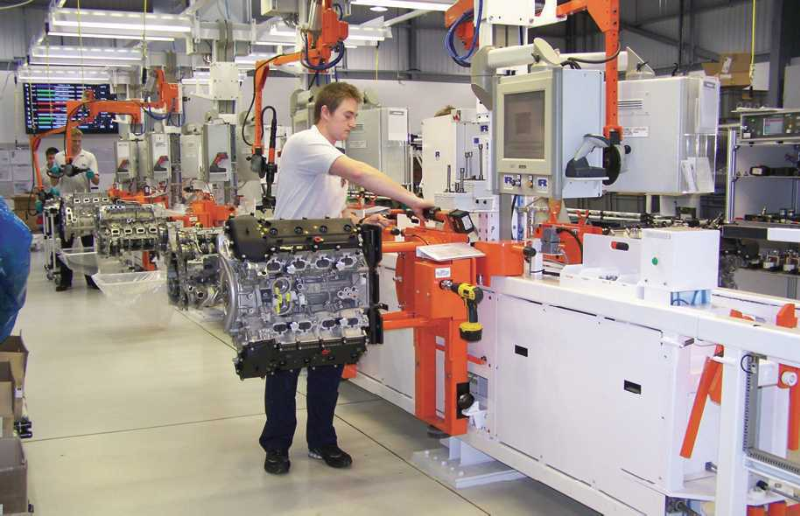 MacDonald Humfrey Automation (MHA) and sister company Exmac Automation have joined forces to help automotive engineering specialist Ricardo create a state-of-the-art 600 square metre assembly facility to build a new high performance engine for the new McLaren MP4-12C road car.
MacDonald Humfrey Automation (MHA) and sister company Exmac Automation have joined forces to help automotive engineering specialist Ricardo create a state-of-the-art 600 square metre assembly facility to build a new high performance engine for the new McLaren MP4-12C road car.
The new facility at Ricardo’s Technical Centre in Shoreham, West Sussex provides a near clean room production environment and has the capacity to produce 4,000 engines annually across two daily shifts. Its core is a 10-station vertical conveyor mini-line supported by incoming materials inspection and line-side delivery of components. Each station is equipped with a sophisticated MacDonald Humfrey ‘Human Machine Interface’ (HMI) providing guidance to each operator on the precise sequence of operations required at each stage of assembly. The tools and assembly equipment used at each station are instrumented, and provide data directly into a central warranty database for each engine built, providing complete finished product traceability.
Each line station is interlocked via its HMI to ensure that all operations and checks have been successfully completed and recorded before the line can be indexed and the engine moved forward to the next station. In addition to the main production line, the facility includes a cylinder head sub-assembly line, dress area and an end-of-line hot test cell that enables the performance of every engine produced to be fully tested and validated.
The brand new facility was specified, designed, constructed and commissioned in just 18 months.
‘No Fault Forward’ assembly
This is the first time Ricardo has manufactured an engine, so Exmac Automation’s previous experience of ‘No Fault Forward’ (NFF) assembly on a similar engine build project for Harley Davidson’s V-Rod engine was invaluable. The V-Rod line was a fully automated EMS-driven loop system but, as there was less space in the new Shoreham facility, Exmac worked with Ricardo to determine the number of stations required and understand the various processes they would need for engine assembly, how engine blocks would be loaded and unloaded from the line, the type of DC-tooling, and the level of control required, etc.
 The design of the Exmac handling system allows Ricardo to load engine blocks onto the line and rotate them at any of the 10 assembly stations. The system is also indexed manually to allow greater control over the assembly process, provide the flexibility to accommodate long cycle times and enable Ricardo to achieve batch production of single engines or different engines as required. To meet the specification within the space available Exmac designed a compact 10-station back-to-back manual line that takes up very little floor space in the new building.
The design of the Exmac handling system allows Ricardo to load engine blocks onto the line and rotate them at any of the 10 assembly stations. The system is also indexed manually to allow greater control over the assembly process, provide the flexibility to accommodate long cycle times and enable Ricardo to achieve batch production of single engines or different engines as required. To meet the specification within the space available Exmac designed a compact 10-station back-to-back manual line that takes up very little floor space in the new building.
Engine blocks are fixed to lightweight trolleys using a vertically mounted slew ring and quick release plate, which mates with a bracket located on the engine bell housing.
Whilst the engine block is locked in place, it can also be rotated through 360 degrees to allow complete access for operators. An engine starts its build sequence at station one and when all assembly functions at that station are completed the control system allows a stop to retract, enabling the operator to push the trolley to a holding position until station two is clear. The system then allows the trolley to be pushed to station two where the same stop and lock procedure holds it in place for that station’s assembly functions to be carried out and so on to station 10.
Trolleys run in a steel track to facilitate manual handling by operators; and a latched turn-post at each end of the line (providing a swing-gate effect) allows trolleys be re-directed to the opposite side of the line after assembly operations at station five are completed. When a trolley reaches station 10 the engine block has been transformed into a fully assembled, complete engine.
Bespoke HMI
Exmac-designed mechanical locking systems accurately locate and secure trolleys in position at each station, whilst also ensuring that they cannot be released until the MacDonald Humfrey HMI system confirms that operators have completed all required tasks at each station, and assembly can continue on a no-faults-forward basis.
The bespoke HMI system developed for the Ricardo engine line takes operators step-by-step through the process of building an engine, providing detailed on-screen information and visual aids at each of the 10 stations, and even including instructions for every bolt to be tightened and its particular torque and angle.
In order to optimise the two-hour engine build sequence, Ricardo also uses the HMI system to monitor the line’s indexing against real-time operator performance.
Exmac Automation
T: 01905 721500

